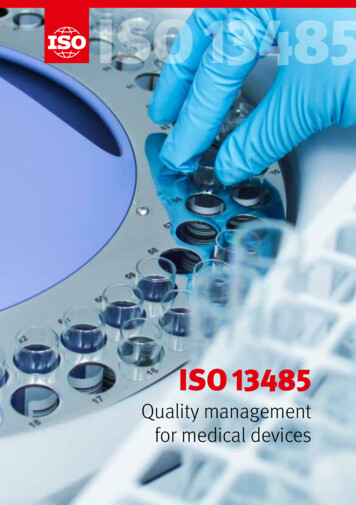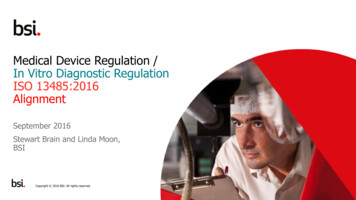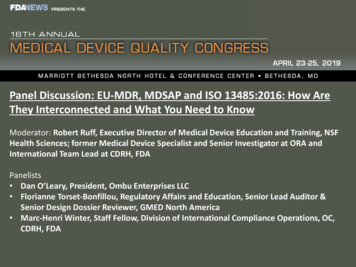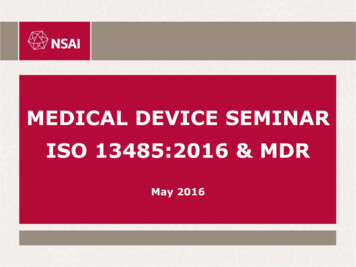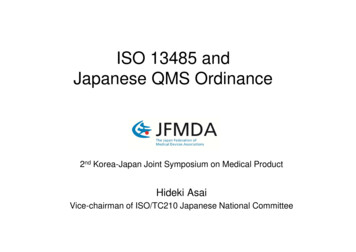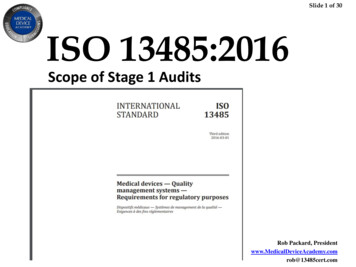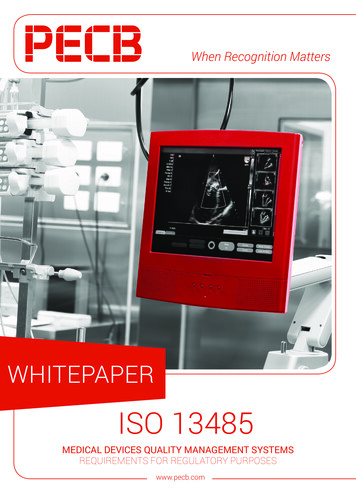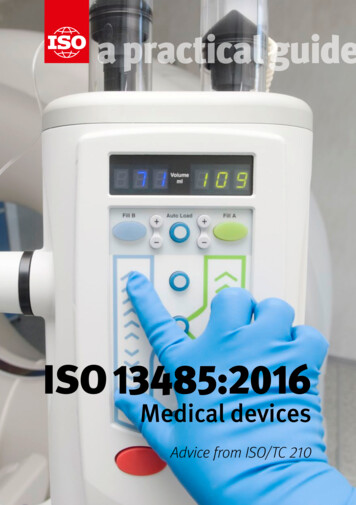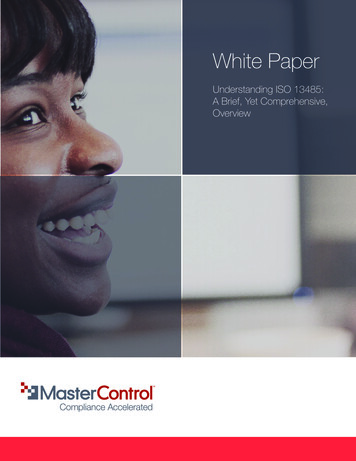
Transcription
White PaperUnderstanding ISO 13485:A Brief, Yet Comprehensive,Overview
OVERVIEWIf you work in the medical device industry, you are aware of the importance of ISO 13485, also referred to as ISO 13485–QualityManagement Systems—Requirements for Regulatory Purposes and ISO 13485:2003. This white paper provides a brief, yetcomprehensive, overview of the standard, and examines how obtaining ISO 13485 certification can open doors to untappeddomestic and international business opportunities. It also explains how to avoid becoming one of the 50 percent of devicecompanies that fail to obtain recertification due to inadequate manual processes.(Editor’s note: This standard is being revised. ISO 13485:201X, as the revision is being referred to, is expected to be availablein Q1 of 2016.)What is ISO 13485?ISO 13485 is a series of requirements that help medical device manufacturers develop a quality management system. Accordingto the official ISO 13485 standard, these requirements “can be used by an organization for the design and development,production, installation and servicing of medical devices, and the design, development, and provision of related services.”1Although ISO 13485 is a stand-alone document, it is often harmonized with ISO 9001, the world’s leading quality managementstandard, which, as of this writing, is also under revision. According to ISO’s website, the revised 9001 standard is expected to bepublished by the end of 2015. (Watch this video to learn more about the proposed changes to ISO 9001.)How Does ISO 13485 Differ from ISO 9001?The most fundamental difference between the two standards is that ISO 13845 is tailored specifically to medical devicecompanies, whereas ISO 9001 can be used by any company, of any size, within any industry sector. Additionally, ISO 9001requires the certified company or organization to demonstrate continual improvement. By contrast, ISO 13485 requires only thatthe organization demonstrate that its quality system is effectively implemented and maintained.Another principal difference is that ISO 13485 excludes the ISO 9001 requirements regarding customer satisfaction, focusinginstead on regulatory requirements as a management responsibility. Finally, unlike ISO 9001, 13485 places great emphasison the importance of risk. It requires device manufacturers, as well as their sub-tier suppliers and contractors, to apply riskmanagement and risk analysis from product development through product realization.It is not uncommon for non-medical device companies to upgrade or migrate from 9001 to ISO 13485 (or to maintain bothcertifications) in order to introduce their existing products for use in medical applications. Device manufacturers that intendto market their products within the European Union will need to address compliance with the requirements of the applicableMedical Device Directive (MDD) and CE marking process. ISO 13485 is recognized as a critical aid in supporting compliancewith the MDD.2How Does ISO 13485:2003 Differ from EN ISO 13485:2012?There are three current and common versions of ISO 13485. The primary international version is ISO 13485:2003. The variantEN ISO 13485:2012 is the latest European harmonized version of ISO 13485; it replaces the prior harmonized version, EN ISO13485:2003, which is now considered to be obsolete. EN ISO 13485:2012 is applicable only to manufacturers placing devices onthe market in Europe. Manufacturers can employ ISO 13485 to meet the quality system requirements of the European directives,including European Medical Device Directive (93/42/EEC). Confusion frequently occurs when people use the abbreviated ISO13485 to refer to both ISO 13485:2003 and EN ISO 13485: 2012. This leads some to assume that there is a 2012 version of theprimary (2003) standard, which there isn’t. The third version is CAN/CSA-ISO 13485:03. Conformance to this standard isnecessary in order to secure a Canadian Medical Device License for a Canadian class II, III or IV medical device. Health Canadaconsiders this variant to be the equivalent to ISO 133485:2003.How is the Standard Organized?ISO 13485 comprises eight sections, which are preceded by an introduction. Sections one through three describe the purposefor and use of the standard. Sections four through eight contain the “meat” of the standard, i.e., the requirements necessary forcompliance, so they will be examine individually.White Paper: Understanding ISO 13485: A Brief, Yet Comprehensive, Overview
Section Four (Systemic Requirements): This section defines the general requirements for compliance. It explainshow to implement and maintain a QMS for devices; prepare a quality manual, quality policy, and quality objectives;control QMS documents; and maintain document integrity. Section Five (Management Requirements): This section defines management’s role in the establishment andmaintenance of an ISO 13485 QMS. It requires upper management to actively participate in quality planning, and toensure that the quality policy is understood throughout the organization. Specific requirements for carrying out periodicmanagement reviews of the QMS, including how often reviews should take place; what to cover; and expected outputs,are also covered in section five. Section Six (Resource Requirements): This section defines the requirements for the provision of resources,including physical resources (e.g., the need for adequate space, tools and equipment); environmental resources (e.g., theenvironment must suit the type of device being made); and human resources (e.g., how to train and maintain competentpersonnel). Key topics covered in section six include the importance of defining employee job requirements and how tokeep good training records. Section Seven (Product Realization Requirements): This extensive section covers everything that is requiredin order to produce a product, from customer requirements to creating (designing and manufacturing), installing, andsupporting a medical device. Requirements are given for how to correctly perform the most basic tasks (e.g., processingcatalog orders), as well as the most complex tasks (e.g., designing from a design concept). Validation; equipmentmaintenance; and risk management, including risk assessment, risk analysis and risk reduction), are also covered insection seven. Section Eight (Remedial Requirements): This final section defines the remedial processes necessary in order tomaintain the effectiveness of the QMS. Key topics covered in section eight include handling adverse events and customercomplaints; conducting internal audits; monitoring and measuring processes and product, including nonconformingproduct; analyzing data; and taking corrective and preventive actions.ISO/TR 14969:2004 is a guidance document for application of ISO 13485. Additional guidance for implementing a medicaldevice QMS can be obtained from the Global Harmonization Taskforce and the FDA guidance documents and compliancemanual.Is ISO 13485 Required?ISO 13485 is required in Canada (CAN/CSA-ISO 13485:03). Japanese Ministry of Health, Labour and Welfare (MHLW)Ordinance #169 is based on ISO 13485: 2003 and is required in Japan. Although EN ISO 13485 is considered to be the de factostandard for the device industry in Europe, it is not technically a requirement. It is, however, the expectation for two reasons:certification to EN ISO 13485 presumes compliance with applicable European Directives (making it easier to obtain CE Marking,which is mandatory if you want to place a device on the market in the European Union) and it’s considered good practice. Inthe United States, the FDA Quality System Regulation (QS Reg.), also known as cGMP, is required. Of course, if a U.S.-basedcompany wishes to market its medical device products internationally, it must comply with both cGMP and ISO 13485.Even in countries where adherence to the standard isn’t required by law, ISO 13485 is becoming increasingly required byinvestors, partners and customers. A 2011 Covidien-commissioned survey of 900 device manufacturers showed that 37% ofrespondents had become 13485 certified to meet regulatory requirements, 31% had become compliant to support regulatoryapproval of products or services, and 28% had become compliant to meet customer requirements.3 Third-party certification to aparticular standard or regulation assures both potential and existing consumers, as well as suppliers and foreign trade officials,that your business operations are safe and efficient. This assurance can lead to tremendous marketing and business advantages.Why is ISO 13485 Important?There are many reasons why ISO 13485 certification might be important to a medical device company, including: Increases customer confidence: Certification establishes a company’s commitment to quality, which often leads toincreased customer confidence; Enhances marketing and promotional opportunities: Once a company has been deemed compliant by acertified ISO13485 registrar, it will receive a certificate. The company’s marketing team will be able to display this2
certificate on all corporate marketing materials to enhance its credibility in the eyes of customers, employees and otherstakeholders; Promotes better communication/fewer deviations: ISO 13485 promotes harmonization of regulatoryrequirements on an international scale. Harmonization allows device manufacturers and other quality experts tocommunicate using a familiar/standardized vocabulary. This reduces communication gaps and misunderstandings thatoften result in deviations, nonconformances and other quality events that can cause patient harm, regulatory sanctionsand significant revenue loss; Improves performance and supplier relationships: Using a uniform, widely-accepted system of process controlleads to improved products and processes. This, in turn, often leads to increased customer satisfaction and betterrelationships with suppliers and partners; Enhances brand equity: Improved products and processes help device manufacturers sustain their delivery of highquality products, and minimize or avoid embarrassing product recalls and costly regulatory sanctions. Ultimately, thisleads to increased brand equity, which is an important competitive advantage; Increases Speed to Market: ISO 13485 certification allows an organization to meet the quality system requirementsof the European Medical Device Directive (93/42/EEC), In Vitro Medical Device Directive (98/79/EEC) and ActiveImplantable Medication Device Directive (90/385/EEC) with less difficulty, which expedites market entry.What are the Financial Benefits of ISO 13485?Many device companies fail to realize how much money they could save (or even generate) by developing and implementing aquality management system that adheres to ISO 13485. Although the standard is not designed to make every medical devicecompany equal in talent or ability, it is designed to help management understand how company processes correspond to ISO13485, and why those processes work in the way that they do. In other words, the standard is designed to make the qualitysystem transparent.Unclear or vague documentation is often what keeps company processes and ISO 13485 compliance at odds. Oncedocumentation presents a clear and deep understanding of how processes and standards fit together, and why they are designedas they are, it becomes easier to spot errors, avoid costly regulatory sanctions and provide effective employee training.Clear training and understandable SOPs enable employees to understand their assigned tasks, as well as any deviations ornonconformance events they are responsible for reporting. The end result: confident employees who are more satisfied withthe company, and their role within it. When employees are satisfied and productive, deviations “bubble up” through the systemfaster, and a positive financial impact is all but guaranteed.According to Quality Digest magazine, there is more than one way to save money by adhering to ISO 13485 standards. “Havinga quality management system [based on ISO 13485 standards] at an early stage provides another advantage to these companies[medical device companies]: quicker market access. Many regulatory organizations were involved in the development of thisstandard. Therefore, requirements in regulatory laws such as the 93/42/EEC MDD share numerous similarities with ISO 13485.Hence, after a simple update of their systems, these companies can quickly and cost-effectively seek regulatory approvals from avariety of countries.”The same article states “For medical device manufacturers, it is mission-critical to receive such certification [ISO 13485certification] quickly. They invest in both research and development, and in the product’s sales and marketing plans. Particularlyin the medical device industry, the longer a product languishes in the review process, the less it returns to the manufacturer’sbottom line.”3Medical device companies can also save a significant amount of money by automating their quality processes, a concept whichwill be expanded on in upcoming sections.How Do I Prepare for ISO 13485 Certification?Preparing for a third-party accreditation audit is a long and tedious process. Many device manufactures, particularly smallerfirms, simply do not have the time, resources or expertise to assess their entire quality management system to identify andcorrect all of the potential barriers to certification success. If time is of the essence, or a dedicated internal resource is notWhite Paper: Understanding ISO 13485: A Brief, Yet Comprehensive, Overview
available, the company may decide to enlist the services of an experienced ISO consultant or quality management certificationexpert to liaise with the registration body, also referred to as the registrar.The certification process is typically divided into five phases.4 If the company is using the services of an ISO consultant, theconsultant will often handle most—if not all—of the phases on behalf of the company. This can save the company a great deal oftime and accelerate the process significantly.Phase One: Inquiry—ISO itself does not perform certification audits or issue certificates. These services are performed byexternal certification bodies. Choosing a certification body is the first step of the inquiry phase. ISO’s website provides some tipsfor selecting a certification body. For example, ISO recommends evaluating several registrars before making a final selection. It’simportant that the registrar you select is competent. In 2013, the European Commission published a report which found that twoout of 11 notified bodies were performing so inadequately, they were ordered to stop issuing CE certificates.5The evaluation process typically commences with a fact-finding meeting between the registrar and the company seekingcertification. During this meeting, the registrar will attempt to gather background information about the company and itscertification needs. The company will want to inquire about the registrar’s working philosophy, as well as what to expect duringthe certification process.Phase Two: Application—If the fact-finding meeting goes well, the company will be asked to fill out a certification applicationform, which can be obtained online. The registrar will review the completed application form, as well as the information gatheredduring the inquiry phase, and provide the company with a quote. Obviously, if the company has chosen to follow ISO’s advice,it will be requesting and receiving multiple quotes, from multiple registration bodies. Once a registrar has been selected, thecompany is ready to advance to phase three.Phase Three: Documentation Review—At this point in the process, the registrar will begin to assess how the company’sdocumented quality processes compare or comply with the standard. During phase three, the company may opt to conduct a trialaudit (often referred to as a pre-assessment) to get a sense of the registrar’s auditing style and to see what quality areas, if any,are deficient. Although a pre-assessment is not required, it is highly recommended.Phase Four: Final Certification Audit—For certification audits, a Stage 1 and a Stage 2 must be conducted prior to the finalcertification audit. The combined duration of the audits must comply with the IAF MD9 guidance document. Section 0.2 of ISO13485 requires auditors to use a “process approach” auditing style, as opposed to a checklist approach. The process approachutilizes the plan-do-check-act (PDCA) cycle.Phase Five: Ongoing Surveillance—Annual or semi-annual surveillance audits should be scheduled with the registrar inorder to monitor progress and correction. These audits should be scheduled well in advance of the company’s anniversary date. Acomplete assessment restarts every three years.(Editor’s note: MasterControl’s Quality Compliance Consulting division offers ISO 13485 application/certification services.If you would like to learn more about QCC, visit http://www.mastercontrol.com/home page ads/need-consulting.html?lne hlnk needconsult. To learn more about automating your paper-based quality management processes withMasterControl software, and how it can facilitate the certification process, continue reading.)Is It True That 50 Percent of Companies Fail to Obtain Recertification?According to an article published in Quality Digest, most small- and medium-sized companies continue to prepare for ormaintain ISO registration through manual processes. Imagine the amount of time it takes to key in or type the required qualitydocuments, physically draw process diagrams, create reports and validate data in preparation for a registration audit. Nowimagine how many days it takes for internal and external auditors to locate paperwork and manually compare the data toinformation provided in the application. Time isn’t the only disadvantage of manual preparation; expense is also a concern. Thearticle estimates that registrations in manual environments still cost more than 100,000, and take an average of one year ofpreparation. Moreover, evidence suggests that up to 50 percent of these registrations fail at the time of recertification due to acompany’s inability to maintain and scale manual processes.6Automating quality management processes with sophisticated software tools can help manufactures not only obtain certificationfaster, but also maintain that certification long term. The following section explains how the MasterControl software suitefacilitates ISO 13485 compliance.4
MasterControl Automates Your Processes for ISO 13485 ComplianceISO 13485 RequirementsMasterControl Features To Ensure Compliancewith ISO 13485( ISO 13485―Sections 4.1.3 and 4.2.1.2 )Requires establishment of a quality management systemfor medical devices. A manufacturer must have qualityprocedures that are documented, controlled, and effectivelyimplemented and maintained.MasterControl helps medical device companies comply withISO 13485 by automating routing, escalation, approval, anddelivery of standard operating procedures (SOPs), policies,and other documentation. The software provides automaticrevision control to ensure that only the current version ofan SOP is available. When a user makes a change to thedocument or record, the user must enter a reason for thechange. The system tracks these changes and makes themavailable through reports.( ISO 13485―Section 6.2.2 )A manufacturer must ensure that its personnel have theright experience, education, training, and skills. Acceptablelevels of competence must be defined. Training needs mustbe established and assessed. A record of competence must bemaintained.MasterControl helps medical device companies comply withISO 13485 by automating the assignment and monitoringof training tasks and grading of online exams. The softwareallows sequencing of training courses so after a prerequisite iscompleted the next course is automatically launched. It alsoprovides a group sign-off feature for verifying training of largegroups of employees.( ISO 13485―Sections 8.2.3, 8.2.4, 8.3.2 and 8.3.3)A manufacturer must plan how remedial processes will beused to assure conformity. It must use remedial processes todemonstrate conformance. It must establish a nonconformingproducts procedure; nonconformances must be corrected anddocumented.MasterControl helps medical device manufacturers complywith ISO 13485 by integrating the corrective and preventiveaction process with other quality processes. A CAPAform can be launched directly from another form (e.g., anonconformance report). The software automatically entersrelevant data into a CAPA form, reducing data entry andeliminating errors that result from the manual transferof information. It also provides customizable reportingcapabilities to help managers monitor the entire qualitymanagement life cycle.ISO 13485―Section 4.1.2 – General RequirementsA risk-based approach is needed when developing processes.Anything that effects the quality system must be viewed froma risk perspective.MasterControl helps medical device companies comply withISO 13485 by allowing users to configure multiple risk typesfor evaluating different categories of operational risk. Riskassessments can be launched from anywhere within theMasterControl system to analyze hazards associated with anyprocess or activity. MasterControl’s best practice process alsoinclude risk mitigation and risk assessment. Standardizingrisk analysis methodologies and assessment results in a singlelocation saves time, money and valuable resources.( ISO 13485―Section 5.6.1 )Requires management reviews, including examination ofproduct conformity data.MasterControl is a robust solution designed to help medicaldevice manufacturers comply with ISO 13485 by automating,managing, and streamlining the process for identifying,evaluating, reviewing, and handling of nonconformingmaterials, components, parts and finished products. Thesolution’s best practice form and five-step process connect allresponsible personnel for effective and timely disposition of anonconformance. In addition, the solution’s scheduled reportsenable management to stay on top of product conformity databy simply reviewing their email.White Paper: Understanding ISO 13485: A Brief, Yet Comprehensive, Overview
(ISO 13485 -- Section 7.3.1)Design and development documentation must be established.Communication and all forms of interfacing must be managedbetween all groups involved with the design and developmentprocesses. Planning output must also be established.MasterControl allows medical device manufacturers tocomply with ISO 13485 by enabling users to control designdocumentation, technical dossiers, BOM iterations and allrelated supplier documentation. The Project Managementmodule also allows MasterControl users to manage all stagesof design and development.ConclusionIn today’s global medical device industry, it’s no longer enough to merely comply with FDA requirements. Medical devicemanufacturers must address the demands of regulators from countries around the world. Achieving ISO 13485 certification is aworthy endeavor since maintaining ISO standards promotes customer, investor, and employee confidence, and builds a systemthat is ideal for automation and increased productivity.References1ISO 13485–Quality Management Systems—Requirements for Regulatory Purposes (official standard), www.ISO.org“What is ISO 13485?”, nqa.com (web page), accessed on December 15, 2014, available from the aus, Jodi, “Medtech Manufacturers Rev Up ISO 13485 Certifications.” MD DI Medical Device and Diagnostic Industry(online), April 24, orsai, Tamas; Dzialas, Gregor; and Ludovico, Brian, “ISO 13485: A Path to the Global Market,” Quality Digest (online),accessed on December 15, 2014, available from the Internet http://www.qualitydigest.com/july07/articles/03 article.shtml4Wichelecki, Steve, “Understanding ISO 13485,” Quality Magazine (online), accessed on December 15, 2014, available from theInternet ding-iso-134855Packard, Rob, “Preparing for ISO 13485 Certification in 5 Steps,” Medical Device Academy (website) December 6, 2012,Available from the Internet ation/6Ramaley, Grant, “The Beginning of the End for Fake ISO 13485 Certificates,” Quality Digest (online), October 27, 2013,Available from the ificates.html7Zwilling, Martin, “How to Start ISO Automation,” Quality Digest (online), accessed on December 15, 2014, Available from theInternet cle/how-start-iso-automation86
Related VideosUsing MasterControl for ISO CertificationMasterControl as a Company-Wide SolutionReducing Risk with MasterControlAbout MasterControl Inc.MasterControl produces software solutions that enable regulated companies to get their products to market faster, whilereducing overall costs and increasing internal efficiency. MasterControl securely manages a company’s critical informationthroughout the entire product lifecycle. Our software is known for being easy to implement, easy to validate, and easy touse. MasterControl solutions include quality management, document management, product lifecycle management, auditmanagement, training management, document control, bill of materials, supplier management, submissions management, andmore. Supported by a comprehensive array of services based on industry best practices, MasterControl provides our customerswith a complete information management solution across the enterprise. For more information about MasterControl, visitwww.mastercontrol.com or call 1.800.825.9117 (U.S.); 44 (0) 1256 325 949 (Europe); or 81 (03) 5422 6665 (Japan). 2015 MasterControl Inc. All rights reserved.WPTTRXXUSENLT-08/15White Paper: Understanding ISO 13485: A Brief, Yet Comprehensive, Overview
Corporate Headquarters:MasterControl Inc.Salt Lake City, UTUnited StatesPhone: 1 866 747 8767European Headquarters:MasterControl Global LimitedBasingstokeUnited KingdomPhone: 44 (0) 1256 325 949Asian Headquarters:MasterControl KKTokyoJapanPhone: 81 (3) 5422 6665Contact information and addresses forother regional MasterControl offices andMasterControl partner offices are listedon the MasterControl website atwww.mastercontrol.com.
Dec 15, 2014 · 13485:2003, which is now considered to be obsolete. EN ISO 13485:2012 is applicable only to manufacturers placing devices on the market in Europe. Manufacturers can employ ISO 13485 to meet the quality system requirements of the European directives,
